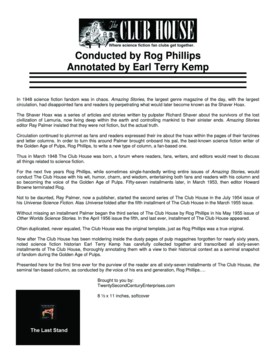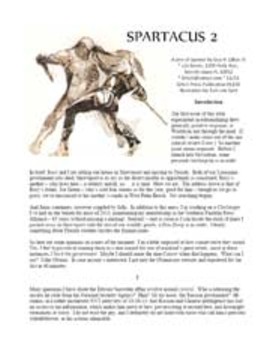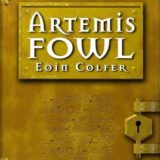
The editorial for this week’s column is dedicated to Roger Phillip Graham, the man who was much better known as one of the greatest science fiction writers of the Golden Age of Pulps, Rog Phillips. The man I knew as my godfather.
Rog was born in Spokane, Washington, on February 20, 1909. Not much is known about his life, and less about his early youth. Some time as a kid, around the age of nine or ten, he got interested in the Electrical Experimenter magazine, Hugo Gernsback’s early precursor to Amazing Stories.
Rog famously once told his pal, 4e Ackerman, about a letter he wrote to the magazine. In the letter Rog talked about forming the first ever science fiction fan club in the United States. His claim predates the formation of any club by any other fan in the country. Rog even wrote about this letter in one of his columns, and how Ackerman looked it up in his massive science fiction magazine collection to bring to Rog at a LASFS meeting.
Rog kicked around the U.S. as a kid, spending some time in high school in Kingfisher, Oklahoma, later attending college at Gonzaga U. (Go Gonzaga!) In his life he worked at nearly every trade, from longshoreman, to night watchman at a funeral home. During World War II he worked as a welder in the shipyards of Spokane.
As the war ended, Rog began his next career, that of pulp science fiction for Amazing Stories.
Ray Palmer, that inimitable salesman, had been editor for Amazing Stories during the war, and had successfully kept the magazine not only afloat, but at the head of the pack. But then one of his most successful ideas backfired on him.
Palmer had fished out a manuscript tossed into a wastebasket by assistant editor Bill Hamling as of no worth. Palmer thought the writer, Richard Shaver, was onto something…thus was born the Shaver Mystery.
At first fans embraced it, and circulation for Amazing Stories skyrocketed. But then Palmer went a step too far for even the most ardent follower of the Mystery, and concluded that it was all “real.”
Palmer was blasted by fans for being a true believer, and foremost among his detractors was 4e Ackerman.
And Rog Phillips, new to the writing scene, and new to Chicago, having taken a $500 advance on his first story from Palmer and made the move from Spokane, was there on the scene ready for another step in his new career, that of hero.
Hero, because Rog Phillips saved Amazing Stories from Palmer’s blunder.
Ray Palmer, his pal, got another brilliant idea, he decided to placate those noisy detractors being led by 4e Ackerman, and have Rog write a fan column, rather a fanzine review column, for the fans, and about the fans. Thus The Club House was born.
The first installment appeared in the March 1948 issue of Amazing Stories. In total 57 installments would appear before the newest editor, Howard Browne, would replace Rog and his column with a story by Robert A. Heinlein, and change the pulp size Amazing to a digest. But that’s another story.
In his column Rog wrote about everything; World War II, the growing conflict in Korea that turned into another war, politics, medicine, mathematics, and fan stuff. He wrote about individual fans, their fanzines, conventions, hobbies, and books. Rog even used his bully pulpit to hawk his own wares.

There are numerous mentions of his very first paperback novel, The Time Trap. First he let slip that fellow writer, Craig Browning, was due to publish one of the first ever science fiction paperbacks. But even Rog had some trouble keeping track of his over twenty pseudonyms and let slip that he was in actuality Craig, and the book his.
His crowning achievement was when Shasta Publishers, that most famous of all the early specialty science fiction imprints, contracted with Rog to publish his novel, Frontiers in the Sky. In several columns Rog would try his hand at selling his upcoming novel. First mentioning that fans should get their order in early and reserve one of the 500 specially signed editions.
There was no question that Rog was on a roll. He was about to make the big time.
Then a cruel twist of fate intervened.
Shasta went bankrupt before his novel was published.
There was a mention of the title as a forthcoming book on the back cover of the Shasta edition of This Island Earth, but that was all.
Shortly after Shasta went bankrupt, Howard Browne was made managing editor of Amazing. Browne had tried unsuccessfully to turn the magazine into a slick, but was given free rein to turn it into a digest. The first thing he did as editor was to cancel all the fan letter columns, and to cancel The Club House. A few years later Browne realized his blunder, but then it was too late for Rog.
Rog fell from the height of his writing career, when he would sometimes write whole issues of Amazing under a series of pseudonyms, and at the peak was earning a $1000 a month (big money in 1953), to almost nothing.
His second wife left him.
He struggled for a while, writing soul searching stories for his pal, Ray Palmer, and his various magazines, Fate and Mystic. Ray Palmer even reintroduced The Club House, running it for nearly ten more installments in his two magazines, Other Worlds and Universe, before it was all over.
Rog fell even more.
But then he did it again. In 1957, 1958, and 1959, he reinvented himself, becoming a science fiction writer of the first rank with such great stories as “The Yellow Pill,” “The Game Preserve,” and “The Rat in the Skull,” which was nominated for a Hugo Award. During these last few years his pulp novel, The Involuntary Immortals, was made into a hardcover by Avalon.
After nearly five years of fumbling around, Rog had clawed his way back to the top of the pack by sheer talent. And then he received the last straw…from noted editor John Campbell. It isn’t clear in his letter if the book Campbell rejected was Frontiers in the Sky, but it probably was. The rejection letter compares it to a recently submitted work by Robert Heinlein, which Campbell also rejected. But being compared to Heinlein must have been salt in a still sore wound for Rog because he stopped writing science fiction.
For the next couple of years, from 1960 to shortly before he died on March 2, 1966, Rog would continue to write…mysteries, telling everyone the truth, that he made more money from them. And then it was over, the big, blustering, towering hulk of a man died from heart problems. He was only fifty-five years old.
His work has languished, moldering inside dusty pulps, nearly forgotten since his death. At one time he was considered the best, and one of the top writers of his generation. Had Shasta published his novel things would have been different for his legacy. There is no question about this.

As a tribute to Rog Phillips, my godfather, and his memory, I’ve spent several years collecting all of his writing. With attention to detail I’ve carefully transcribed all 67 appearances of The Club House, editing them for consistency. I’ve added over 300,000 words annotating the nearly 300,000 words he wrote in his column, all with an eye toward finding a context for the people, their times, and what they did and wrote in their fanzines. Now I’ve just completed the index with over 5,800 single items, and more than 14,000 individual entries.
And just like Rog, I’m using my bully pulpit to bring the upcoming publication of this massive, nearly 630 page, 8 ½ x 11, softcover tome, to the attention of the reading public.

I’m taking advance orders for a limited number of signed editions (just like Shasta once offered). The preliminary price will be around $25 to $35 a copy (shipping not included…ha ha!). The final price and number printed will depend on interest. So, let me know, and place your order now! One thing is certain, only a limited number of signed copies will ever be offered to the public. To place your order, or contact me directly: The Club House
So, now on to The Club House in its latest reincarnation….
***

Science Fiction/San Francisco #147: December 2013. Monthly. 41-pages. Edited by Jean Martin. Cover “Willie Mays” by Lucy Huntzinger. Editorial by Jean Martin. In her very entertaining editorial Jean tells us more about costuming fandom in the Bay Area. Some events scheduled for the past few months were cancelled, some went on, and Jean even won an auction “for renting two costumes from the SF Shakespeare Festival costume shop.” A pretty big deal! She rounds off her editorial with more comments on current television shows that she favors. In “The Date You Don’t Want to Forget: Why Pop Culture Anniversaries are Important,” by Christopher Erickson, he makes a connection between all these upcoming anniversaries and the creation of friendships, marriages and connections between parents and their children. However, when he says: “As people who follow a seemingly irrelevant media…” I don’t agree, when I did with most of his other points. I don’t think that this media, science fiction, is irrelevant, in fact, I thought that Erickson had made a much better case for its mainstream impact. “Lost Horizon Night Market,” by Michael Boehm, is an excellent article about a seeming new fad, that of following artists to nearly secret, nighttime shows of their artwork, conducted from the back of trucks and vans. “New Steampunk Group in San Francisco,” by Aaron Almarza, in which Aaron elaborates on his attempts to enlarge and from a broader group of Steampunk fans. For more info try: www.sfsteampunk.com “Interview with Fantasy Author Diana Paxson,” by Jean Martin. This is a touching and in-depth interview with a contemporary and collaborator of Marion “Astra” Zimmer (better known as Marion Zimmer Bradley). “’Intergalactic Nemesis’ Review,” by Jack Avery. Jack tells us about an intriguing group of touring performers, The Intergalactic Nemesis. These performers do a “Live-Action Graphic Novel” production as a live stage show combining projected comic book-style artwork with audio drama performances to tell a retro-pulp science fiction tale. By all accounts, catch them if you can. “Monster Mash: The Gaskells Halloween Ball,” by Christopher Erickson. This article is profusely illustrated with photographs of costumed attendees. Letters of Comment. Lloyd Penney gives with an update about his life, interests, and conclusions about fannish things. BASFA Meeting 1212. In some great detail we find the minutes of the last Meeting given, and note that Chris Garcia is the Vice-President of the Club. Sounds like this is a fun club. If your in the area, read this zine, and contact the group for more info. Bay Area Fannish Calendar. This calendar of upcoming events runs through September, so plan accordingly.
***

Broken Toys #23: December 2013. Monthly? 20-pages. Edited by Taral Wayne. Canadian fan, Taral, is back with his personalzine in which he tells us that he is a “retired fan & humbug.” Taral jumps right into it with “Late Middle Age Crisis, or Early Old Age Senility?” in which, in keeping with the title, he lets loose with what he calls a hefty dose of self-pity wherein he describes his latest health problems, diagnosis, and treatment. Taral changes pace with “Crew Mates” wherein he entertains with his views on a Star Trek quiz. Next is “Paying the Troll,” about common plagiarism among artists. “Left-Over Parts” is the title for his letter column, in which he gets even more up-close-and-personal with various friends and regular letter writers. “King of the Grill” follows, and is sort of a con report for a steak house visit. Next is Steven (aka Baldardash) new smash hit, “Mayoral Travesty” which is a song about Toronto’s bad-boy mayor. In “Emotorial—It Can’t Get No Wurse!” Taral continues his health rant. Taral remains an interesting read.
***

Nowhere Fan #2 was first published by Christina Lake for Corflu XXX in Portland, Oregon, May 2013. This is the next issue, #2. 10-pages. In her editorial Christina covers the gamut from the news media to running a marathon, complete with personal photo and medal. She follows this with an article, “Is SF fandom utopian?” Without spoiling her article, she does end with another question, whether she (and others in British fandom) are too cynical to ask and answer this question. Next Lilian Edwards gives with a con report for the Nine Worlds convention in London, “If that was Nine Worlds, will the next one have Ten?” (It does seem that these Brits do like to ask questions, and then try to answer them.) She does seem to answer her question, at least in part, indicating that we need these youthful, creative, and entrepreneurial types more than they need us at conventions. This is followed by “The Ever Expanding Bristolcon Experience,” a more conventional con report, albeit a short one at that. Next Doug Bell gives with a book review in “The Carhullan Army, Science Fiction and Me.” He likes it, but falls short of recommending it. “And it all started with a big bang!” You guessed it, is about the television series by the same name. And finally in letters, Lloyd Penney makes a great point: “The only person I know who makes a living out of writing science fiction is Robert J. Sawyer.” This is a very pertinent observation, one that should be made more often, and with more detail. Science fiction writing as a way of life is not sustaining, most writers have to get a “real” job in order to do what they love. All in all this is a very nicely written zine, and shows great promise. Let’s hope they keep pubbing.
***

Spartacus #2: December 2013. Frequency ? 8-pages. Edited by Guy H. Lillian III, as “a zine of opinion.” Guy pubs several other zines, Challenger and Zine Dump, and is a 43 year member of the Southern Fandom Press Alliance, quite a feat! In this zine, Guy stretches his editorial wings and gives with his views on politics, beginning with Obamacare, which he is for. He is against Snowden considering him a traitor. So, what price freedom, Guy? Conformity to the U.S. war machine? Guy makes a much to invidious comparison of Snowden to Ellsberg. Different times, much different. In Ellsberg’s case, the masses were against the war. In Snowden’s case, the masses were for any war, anywhere, at anytime, against any loosely defined enemy. (I’m still waiting to see Saddam Hussein’s weapons of mass destruction…but that’s just a trivial point, right Guy?) Next Guy delivers some in-depth views into the Kennedy assassination as a single-person crime. His writing is at times cogent, when he is not trying to press his point; after all, it comes naturally; there being only two possibilities. Either Oswald worked alone, or he was a patsy. There is no third case. Next Guy covers his views on bullies in our society. Clearly, Guy is much more convincing when carefully discussing something he knows about, such as the JFK case, rather than just giving his views on public events. It isn’t quite clear where Guy stands, whether he is for or against being bullied, but who cares, right, even chums do it! The letters of comment demonstrate that Guy is a member of high standing in fandom, and his comments and views are taken seriously, even if they are mostly agreed with instead of taken critically. Too bad! Good views, such as Guy maintains, clearly elucidated, are a rare thing, and should be critically reviewed in order to derive a sounder position. Oh well, if debate and extreme politics are your thing, this is the zine for you.
***

Corflu Progress Report #1: December 2013. Irregular. 12-pages. Edited by Nic Farey. Corflu, the convention of fanzine editors, will be held in Richmond, Virginia, May 2-4, 2014. This is the update for that convention giving more details about joining, hotel rates, etc. It is intriguing that Nic managed to put together 12 pages. This con has no scheduled events, and is essentially a roving party for the entire weekend. The padding…excuse me… this elaborate zine contains a lengthy history article about Richmond. Murray Moore has a brief article, “Fanthology,” in which he plugs his forthcoming work-in-progress book. Something must be going around! Fan writer, Andy Hooper, sets the stage for this year with “2013 FAAN Awards,” in which he tells us more history and what’s going to happen this upcoming year. Octogenarian Ted White, a former editor of Amazing Stories, gives with “fwa” in which he tells us the history of this sub-group, The Fan Writers of America, and how it awards members. He ends by telling us that he is the dictator that runs “the selection process with an iron fist (in a velvet glove). Rob Jackson, in “The Corflu Fifty” tells us about this fan fund which is used to bring worthies to the con who might not be otherwise able to attend. The Progress Report ends with a list of currently registered members. It’s not too late. There’s still time for you to join. This convention is one of the very best. It is small, close, and fun. Lots of time to chat, drink, eat, and be merry.
***
Now for a facile segue from Corflu and the center of fandom to all things Shaver, who had his roots in Amazing Stories…
Details are available at: Shavertron

Shavertron #3: Spring 1980. Quarterly. 6-pages. Edited by Richard Toronto. In this issue we learn that “Weak Microwaves May Alter Cells,” in an article written by science correspondent, Charles Petit. Richard Toronto reveals the first of six “Record of Rocks” Richard Shaver features done in the style of Ripley’s “Believe It or Not.” In his editorial, Toronto tells us that Shaver was one of the very first anti-nuke activists. Next is “ask Doc Shaver” in which Shaver tells us how to get rid of brain fever…a cold shower. There are several priceless news clippings, some about UFO’s. Of special note is the reprint from the original Shaver Mystery Club Letterzine. This letter, and response from Shaver himself, ask about how to find and splunk a Dero cave. Next is “Easy Ways to See Rock Images,” by Bill Bliss, in which Bill tells us all we need to know about rocks, and their hidden images. The “Letters” page tells us that this is a well read zine, with many prolific letter writers letting us know what is on their minds. The last page is covered with several newspaper clippings of the Fortean type; people disappearing into thin air; man disappears; the lights go out; and “Mystery Man Flies in Box to Seattle.” This zine is a fantastic collection of ephemera collected by Richard Toronto, the man who continued in the tradition of Shaver and Charles Fort, bringing us their canny worldview for another generation. This collection is highly recommended reading.
***
So, once again, sadly, we reach the end, but don’t despair, we’ll be back next week with more fanzines, more convention reports, more info into your favorite fan clubs meetings, and more political editorials than you’d care to shake a stick at. In the meanwhile, don’t forget to order a copy of my book, The Club House….










Good zines, all. Say Terry: I’m mailing out the latest issue of my perzine ASKEW right now, so if you’ll be kind enough to let me know what your snail mail address is (let me know via e-mail; look it up on efanzines under ASKANCE 29) and I will add your name to the mailing list.
Thank you!